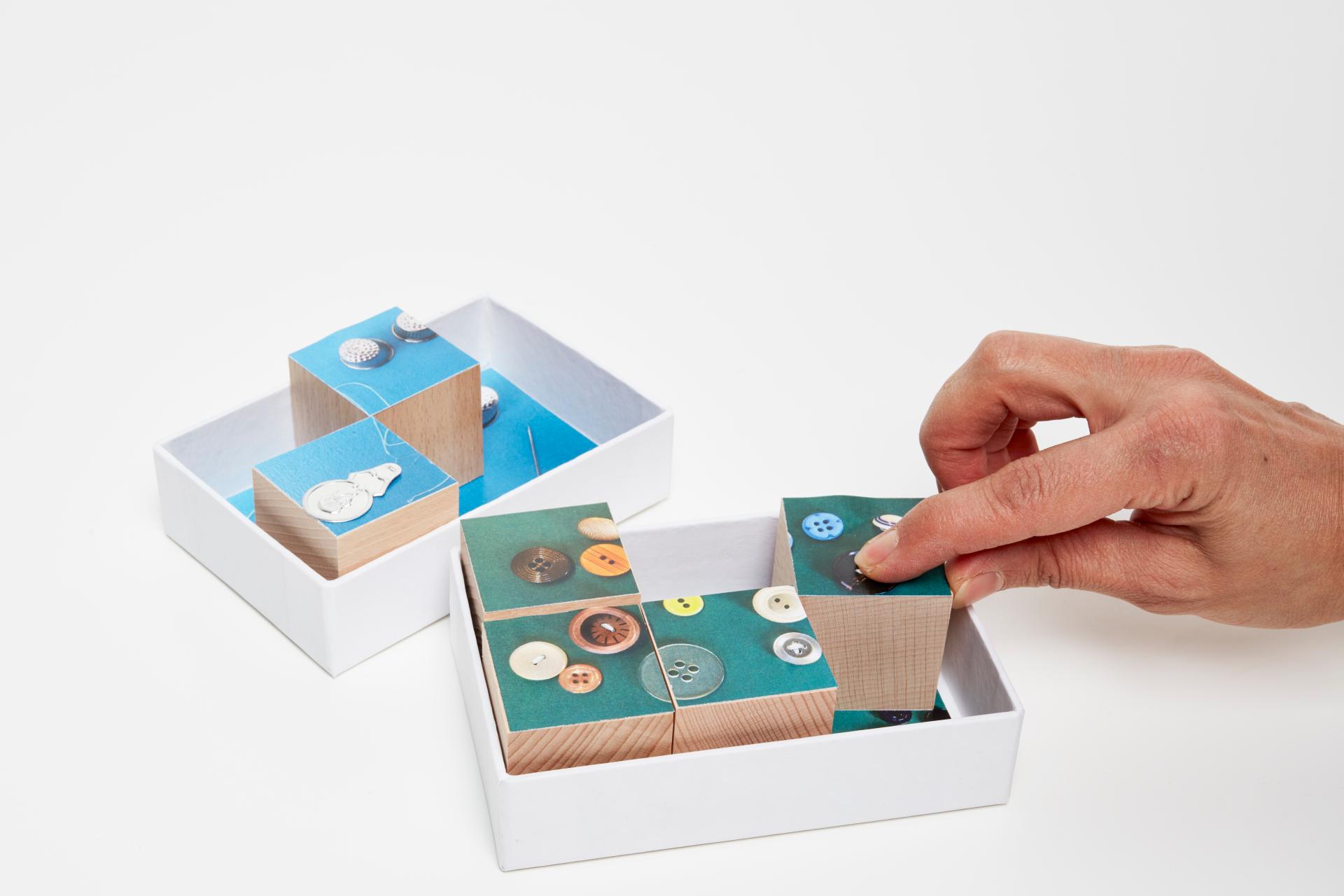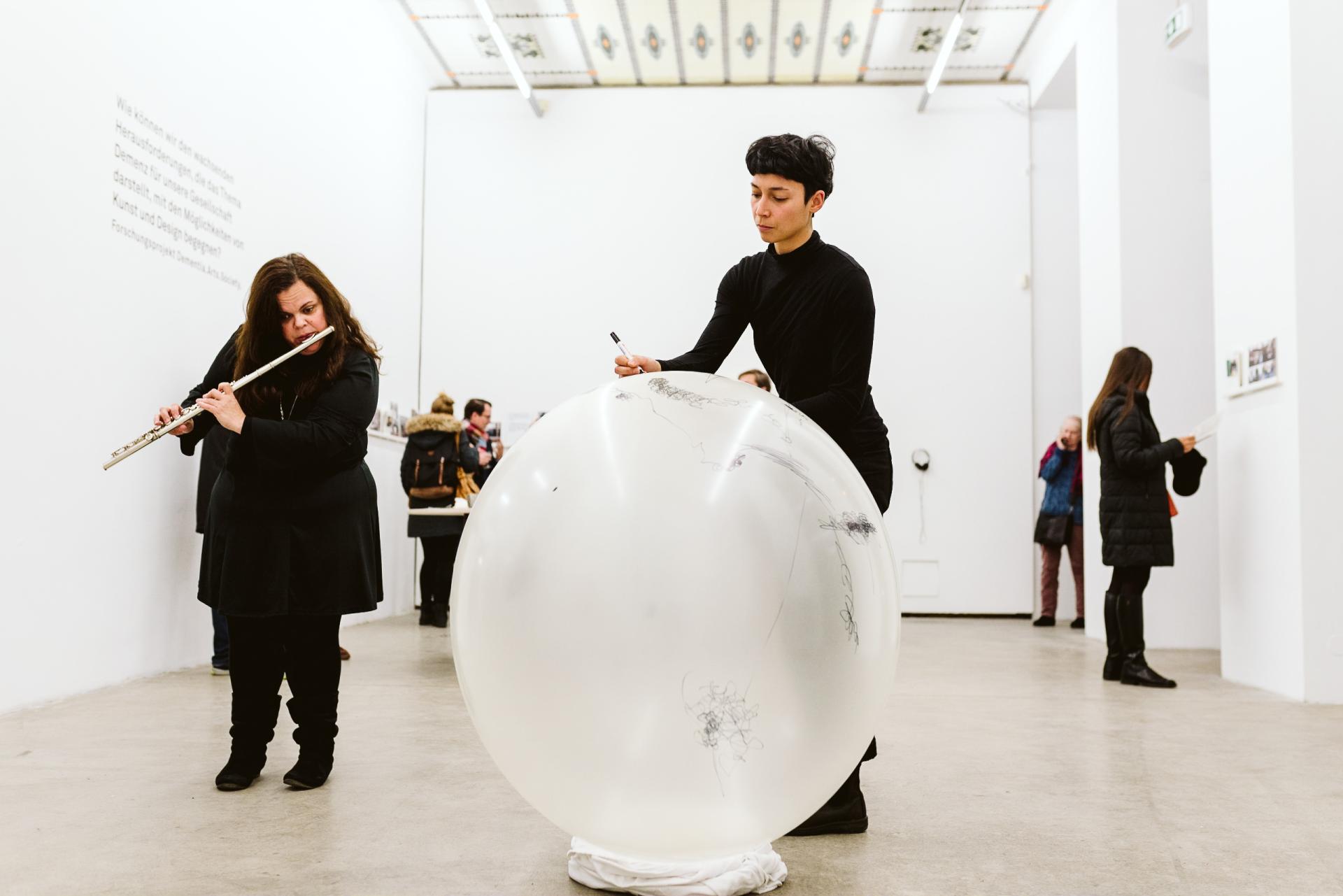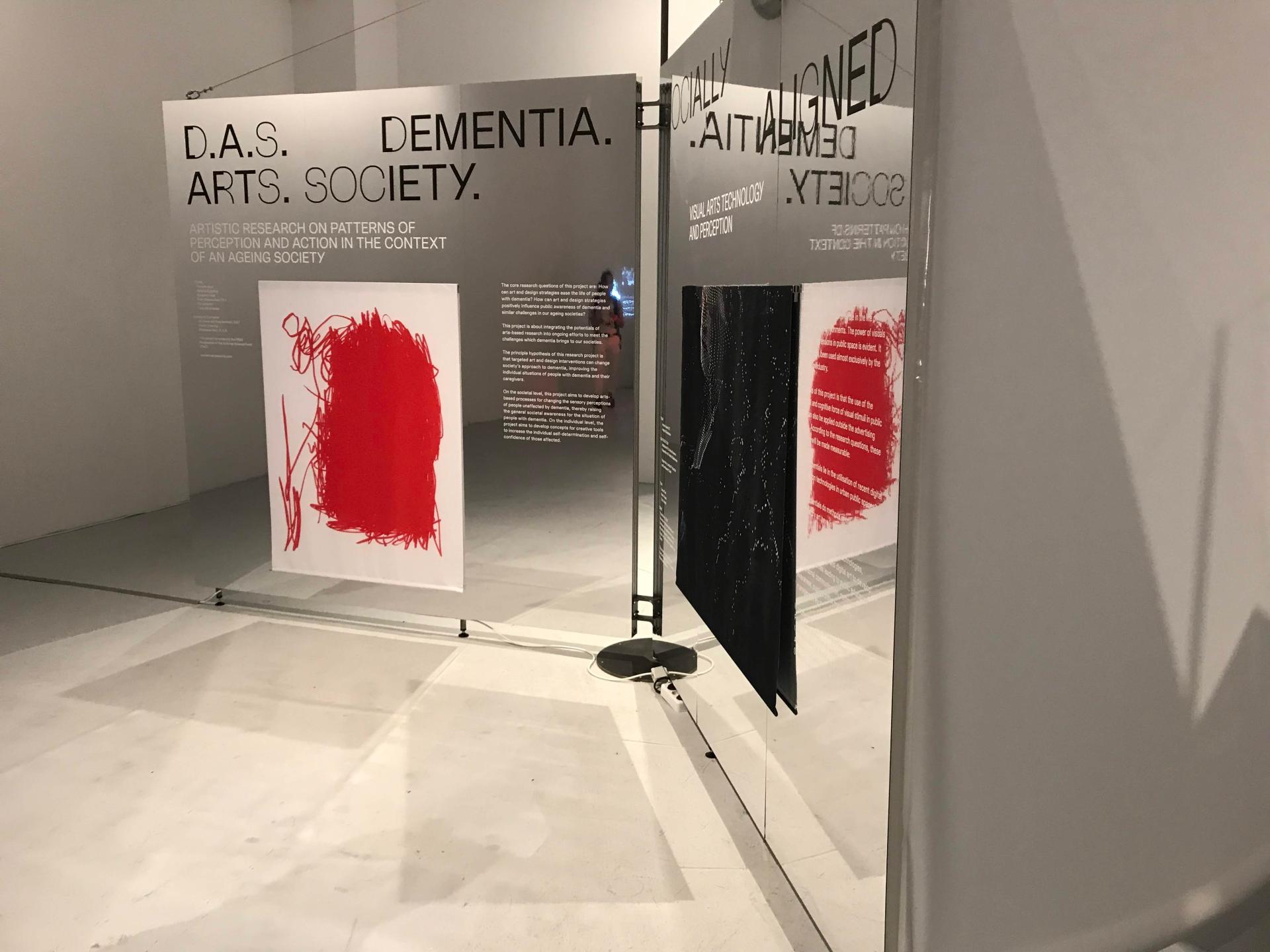Dementia.Arts.Society (D.A.S.)
Basic information
Project Title
Full project title
Category
Project Description
Dementia (cognitive impairment) an umbrella term describing a chronic disease of the brain, followed by gradual deterioration of cognitive, emotional and social skills often leading to a complete withdrawal from society to avoid rejection and embarrassment. The research project D.A.S. has achieved positive change of both public perception of dementia in society and individual circumstances of people with dementia, carers and relatives by means of art and design strategies and artistic research.
Geographical Scope
Project Region
Urban or rural issues
Physical or other transformations
EU Programme or fund
Which funds
Description of the project
Summary
The umbrella term Dementia (now: cognitive impairment) describes a chronic disease of the brain usually arising in old age. Due to demographic development in society, it has become a critical health topic. Worldwide 55 million people are currently living with dementia (Gauthier 2021) with an estimated increase to 78 Million by 2030 (ibid.). For people living with dementia ordinary tasks such as shopping, running errands or traveling to unknown places usually become exceedingly difficult. This often leads to a withdrawal from society to avoid rejection and embarrassment as people with dementia often experience social stigma. D.A.S. was awarded funding by the Austrian Science Funds (FWF). The project's objective is to instigate art & design strategies, art based research, and art therapy; all of which has positively impacted the public perception of dementia and the individual circumstances of people living with dementia as well as of their caregivers. People who do not have dementia should be enabled to emphasize with people living with dementia via changes to their own sensual perceptions. Wide-ranging methods and techniques are applied in workshops and research: observing and interacting with people with dementia as well as caregivers, expert discussions, design strategies, narrative drawings, photography, video and projects with design objects developed for this purpose in public spaces and much more. Workshops allow for diverse individual experiences empowering the autonomy and self-esteem of people living with dementia and offering support for a greater participation in society; research results are disseminated and shared with caregivers, designers, family members, interested people and conference attendees. Where social policies, therapy, care and medicine reach their limits, art and design strategies aim to open up new perspectives for people living with dementia in regard to their own capabilities and their situation within the social environment.
Key objectives for sustainability
D.A.S. is sustainable and part of a circular economy or rather a circular society in two respects: in the traditional sense, materials used for workshops, interactions and the artistic products and design objects focus on sustainability, such as the upcycling of what already exists and of what is no longer used, as well as recycled, renewable, raw and natural materials. The materials and objects were always reused or passed on and thus became part of a sustainable cycle, for example within a care facility.
Much more importantly in terms of sustainability, however, is another cycle: that of knowledge, empathy and communication. By working with people with dementia, learning from their experiences and needs, and making these experiences visible and tangible for people without dementia, a first step was taken to break the cycle of stigmatization and stereotyping and instead initiate a cycle of empathy and communication. Sustainability is achieved by creating points of contact, understanding and support that reach far beyond D.A.S and its follow-up project DEMEDARTS. For example, new and innovative projects for people with dementia have been established at the local level in Vienna, with the support of the D.A.S expertise and motivated by its experiences, such as specially developed programmes by Arts for Health Austria (https://www.artsforhealthaustria.eu) or within local museums. Artistic research in the field of dementia is also increasing in the international context, many of those inspired by D.A.S.' art & design approach to meet dementia (now: cognitive impairment). People of all ages with diverse backgrounds and circumstances became part of the artistic research in D.A.S. and were empowered and encouraged to share, communicate and use the experiences gained in the project for the benefit of the community. With D.A.S, we managed to initiate a social cycle in the context of dementia on a local but also on an international level.
Key objectives for aesthetics and quality
D.A.S succeeded in offering projects based on methods of art and design for people with dementia, their relatives and caregivers, as well as for people without dementia. D.A.S. projects in public spaces as well as in nursing homes for people with dementia contribute to empathy building and aim to make everyday routine more worth living for people with dementia and their carers. Using the example of the project sensual fake, the path from art and design to an artistic intervention in public space will be described. The location is a public café, the waiters are in the know, the visitors are unsuspecting. The following scenarios take place: ONE: A cup of coffee is ordered and, as usual, a glass of water is served with it. The glass seems to be filled, but the water’s surface is slanted, there is no water in the glass. The waiter will always bring such a glass, but he will deny knowing what the problem is. TWO: An at first sight seemingly ordinary coffee house chair falls to the side as soon as weight is put on it, as only three of its four legs are stable. The customer is forced to use the own legs for stability. THREE: A customer is served soup. The bottom of the soup bowl has been raised. When the customer dips their spoon into the bowl they are startled to find that the bowl is only a scant centimeter deep. FOUR: A customer orders a meal which is served with cutlery made out of pasta dough. When used, the cutlery bends and breaks, making it ineffective for its intended use. Through the design objects, an everyday situation becomes a challenge fostered by uncertainty and confusion. The unsuspecting participants experienced first-hand how it feels to no longer be in control of an ordinary situation, to distrust their own senses and to experience rejection and stigmatization. Through art and design projects such as the example sensual fake, D.A.S. takes a unique pioneering step in conducting research in the field of dementia through interdisciplinary artistic methods.
Key objectives for inclusion
D.A.S.’ aim to build empathy in the general population is made possible through close cooperation and learning with and from people with dementia. All projects were open to public and always based on the specific necessities of participants and contributors. Workshops were deliberately developed to meet the needs of people with dementia (now: cognitive impairment). Two examples illustrate the participation of citizens more clearly:
Sensory workshops, working with people with dementia in nursing homes, aim to anchor positive memories, based on visual impressions (e.g. photographs people with dementia brought with them). The anchors were used as starting points to create design objects (give-backs). Not only do these objects have an aesthetic appeal, but also use the possibilities of art and design to support people with dementia and their carers in everyday life. Based on questions of how design objects can create space for sustainable interaction, the give-backs allow people with dementia to immerse in memories and open up important sensual incentives - such as haptic or olfactory experiences - for communication, that people with dementia, their relatives and carers usually only rarely have.
Perception workshops in public spaces call attention to challenges people with dementia face everyday. They change the perceptions of people without dementia by destabilizing normal trust in everyday perception, via design objects distorting the visual sense and sense of hearing. Experiencing spatial disorientation, uncertainty and overstimulation in public spaces – thereby making people realize what it means to be dependent on help, understanding and empathy – fosters public awareness and initiates reflection on dementia. These experiences, as well as those of sensual fakes, for example, are discussed, presented and reappraised, and give rise to an examination of the needs of people with dementia and how these can be met in a sustainable and forward-looking way.
Results in relation to category
The World Alzheimer Report 2021 notices that “stigma and negative stereotypes associated with dementia prevent many individuals, families and carers from seeking the help and support they need” (Gauthier et al. 2021, 29). This is why they recommend “improved dementia training and education [...]” (ibid, 23), and call “for the development of culturally appropriate awareness campaigns [...]” (ibid, 21). D.A.S. consciously confronts these stereotypes. Artistic research, art based interventions, art and design objects have been developed explicitly for the purposes of 1. supporting people with dementia and their relatives in their challenging everyday lives and 2. counteracting these very stigmas and stereotypes in people without dementia through empathy building and art education. D.A.S.'s artistic interventions and projects open up ways of communicating with people with dementia that go beyond linguistic difficulties often arising with dementia. They give rise to the (re)integration of people with dementia by overcoming barriers with help of specifically designed objects, maintaining or even regaining quality of life. Through the interdisciplinary collaboration of visual artists, designers, musicians, performers, researchers and citizens, D.A.S. creates a basis of impulses to foster solutions in dealing with dementia that could be created worldwide. The project has attracted attention through exhibitions, actions in the framework of art and design festivals, addressing people to get more empathy and understanding for people with cognitive disabilities. The project has been exhibited all over the world (Vienna/Innsbruck/Linz (AU), Brno (CZE), Dunedin (NZ), Singapur (SG), London (UK), Budapest (HU), Montreal (CA), LosAngeles (USA)). Aesthetic reflections on this difficult topic that affects us all (dementia will unfortunately remain the biggest epidemic before and after the pandemic) within D.A.S. offer sustainable engagement with the topic on the most diverse level.
How Citizens benefit
D.A.S. local and national reach was made accessible to a wide audience at conferences and exhibitions. E.g. the exhibition Status Quo, gave an insight into D.A.S. and revealed its initial, interim results. During the show’s four-week run, visitors were able to attend different workshops and were themselves involved in artistic research. For the so-called archive of confusion, an artistic research project within D.A.S., based on a citizen science approach, more than fivehundred participants in Austria, Germany, Switzerland and Canada between 3 and 103 years old were asked to draw their image of confusion and its opposite. These mental images were collected and morphed by the computer program “Morph Age” and evaluated by means of artistic research according to similarities and differences. They then provoked empathetic discussions concerning mental states of confusion by people with dementia (now: cognitive impairments). The drawings were interpreted by musicians into graphic notations in public spaces during an Art Festival in Brno and the Vienna Design Week. An audible Archive of Confusion emerged. The artistic research led further to the co-composition Confused Confusion by Igor Lintz-Maues et al. The involvement of people with and without dementia, in the development and implementation of the research project and its artistic interventions - exemplarily shown with Status Quo and Archive of Confusion - not only opens up significant insights into the everyday lives of people with dementia their relatives and carers, but also makes it possible to learn directly from them. The needs of these people were directly addressed and implemented through artistic research and art and design objects and thus made tangible to an even wider field. Through these direct approaches, D.A.S. created a basis for empathy building and to fight exclusion by and withdrawal from society. D.A.S. visualizes ways of (re)integration and participation of people with dementia in society.
Physical or other transformations
Innovative character
In December 2018, 189,969 publications related to dementia (now: cognitive impairment) could be found on PubMed, in 2022 there are already 242,955 search results. These numbers are impressive, though only four medications were introduced to the market in the last twenty years. Where medical research is stagnating, art seeks innovative and alternative approaches. As the subject of dementia is located within health studies, art therapy is mostly associated when it comes to bringing together arts and dementia. Methodologies of the arts are applied in diverse approaches within health context but with different intentions and objectives. Art Therapy is a type of therapeutic technique rooted in the idea that creative expression can foster healing and mental well-being. Shaun McNiff, one of the pioneers of Arts-Based research first combined Arts-Based Research and Art Therapy. The combination of Art Therapy and Arts-Based Research allows a completely different approach, where artists and people with dementia interact. The Arts-Based method provokes entering an interpretive dialogue and critique of the experimental activity which generates ideas and connections to new possibilities for inquiry (McNiff 2009, 153). So whereas in art therapy the therapeut will empower the patient to express via creative means, in D.A.S. the artists interacted and responded, interpreted, generated new inquiries and interaction tools for communication for people with dementia, their caregivers and society through arts-based research. D.A.S. shows how empathy and respect can be build within society and how the life of people with dementia and their carers and relatives can be enriched by means of art and design interventions, art and design objects (such as the earlier mentioned give-backs or sensual fakes) “and how artistic research can have an impact on the cross generational well-being of people living with the condition” (Mateus-Berr & Gruber 2021, 9), and those who are not.
Learning transferred to other parties
D.A.S. initiated and organized two cross-disciplinary conferences, inviting experts and project partners to give public lectures. During both events, expert discussions were hosted by the research team where new insights and experiences in the fields of science, art, design and social organizations were discussed and put into context. The main focus of these public lectures and discussions was to exchange experiences between concerned and interested people: designers, researchers, relatives and caretakers. However, the results of the artistic research, art and design interventions, workshops and events were not only made accessible to a broad public at conferences, exhibitions but also served as the basis for another three-year research project. DEMEDARTS. Here, the knowledge already gained in D.A.S. is built upon and the topic of dementia is researched to an even greater extent and, above all, made accessible to population groups that usually have little access to artistic research and/or experiences with dementia, e.g. school and university students as well as people in care, who benefit greatly from the artistic workshops in their everyday dealings with people with dementia.
Furthermore, two pioneering publications based on the artistic research projects were brought to the market: The bilingual publication Dementia. Arts. Society. Exhibition and the joint publication Arts and Dementia. interdisciplinary perspectives. Both are groundbreaking in the field of artistic research in the context of dementia. They show how D.A.S. and the artistic research in the context of dementia initiated by the project are pioneering interdisciplinary approaches in the fields of design, visual art, music, museum education, architecture and performance that address individuals living with dementia, people working ‘on the front line’ with those living with the condition as well as people conducting research in the field of dementia.






